1 - Expected post-Chinafy results
The Ultimate Guide to How Developers Develop Drupal Websites for China
In this all-in-one guide to Drupal, we will introduce the platform, go through common issues and their solutions, learn about Drupal’s performance issues in China and the reasons behind them, examine a case study of a website built on Drupal, and more.
What is Drupal?
Drupal is an open-source web publishing system used by over 1.5 million developers and content owners alike.
Drupal boasts itself for being not only a tool for content management, but also a tool to develop tools for content management, calling itself the best digital experience platform (DXP) globally. Their API-first architecture and robust customizability option make it a preferred option for developers who want more fluid control over their builds.
As of today, Drupal community has launched over 3,000 themes and 48,000 modules to offer increased customizability.
In 2022, Drupal websites make up 13% of the world's 10,000 most visited websites with notable users including Harvard University, The Economist, and BBC.
Why do Developers use Drupal?
Developers looking for more dynamic control over their builds often look to Drupal. As a Content Management Software (CMS), it has been described as…
Highly customizable
Implements an Agile Methodology for development
Offers a higher level of security when compared to Wordpress and Joomla. Through fewer and more intentionally designed third party plugins, Drupal also enjoys fewer points of failure in its security set-up.
Has exclusive features for website optimization
Is highly scalable
Has a large and active community, with developers able to draw open other developers, designers, and users.
How does the average Drupal website load in China? And Why?
Like most websites on the internet, Drupal websites similarly encounter the same challenges that plague the others - speed, and functionality.
When accessed from China, Drupal websites are on average:
6x slower than they are globally, with
47% average packet loss
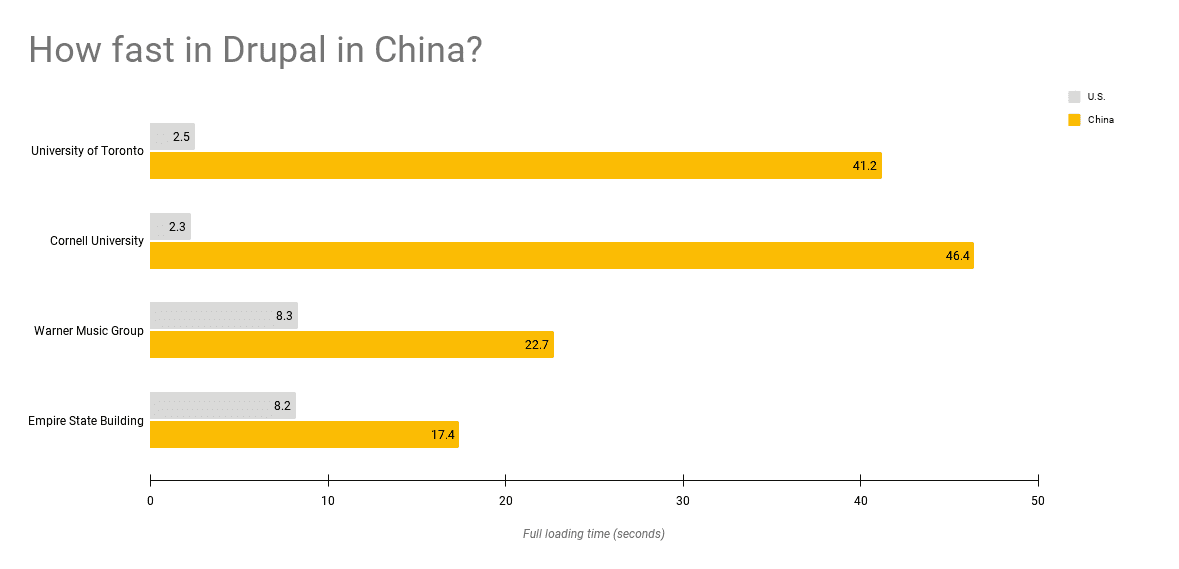
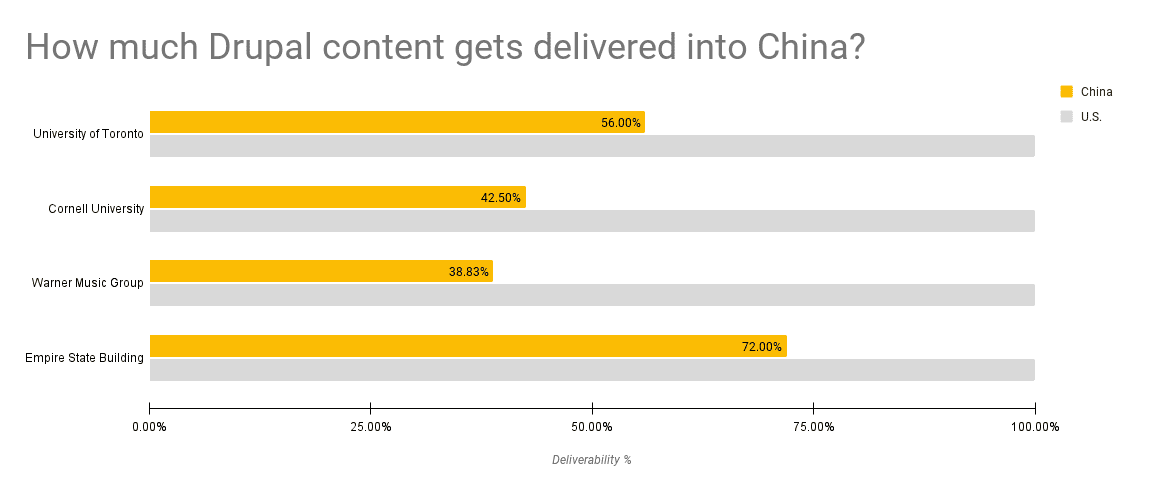
Quick Summary: Most websites don’t work in China for three primary reasons:
i) They are entirely and officially inaccessible in China (e.g. Facebook / Google)
ii) They are built with resources, plugins, libraries, tools or content management systems that are incompatible or perform poorly in China
iii) Their infrastructure is not well-designed for China
Does it mean all websites are inaccessible in China? Not quite.
Chances are that most Drupal websites actually appear broken and are mistaken as inaccessible because of technical challenges they have when loading from China.
Why do most Drupal websites load slowly from China?
Most websites - irrespective of how they're built (e.g. Drupal, Shopify, Adobe, Wordpress) - do not have an infrastructure that's specifically designed for China.
This is not as much of an issue for markets outside of China, as even distanced regions generally are able to load within similar time ranges.
However, the Chinese internet has been created to be a little different from the rest across both management, regulations, and behavior.
The technical limitations faced come down to two key infrastructural components:
The hosting servers both for the website, but also the servers hosting their third party tools and
Content delivery network (CDN) providers (more on this later)
For example, let’s assume your website’s media assets are hosted in the US and delivered within North American using Cloudflare’s Global CDN.
The combination of a US server with North America CDNs would generally be great for performance. That is, for visitors outside of China.
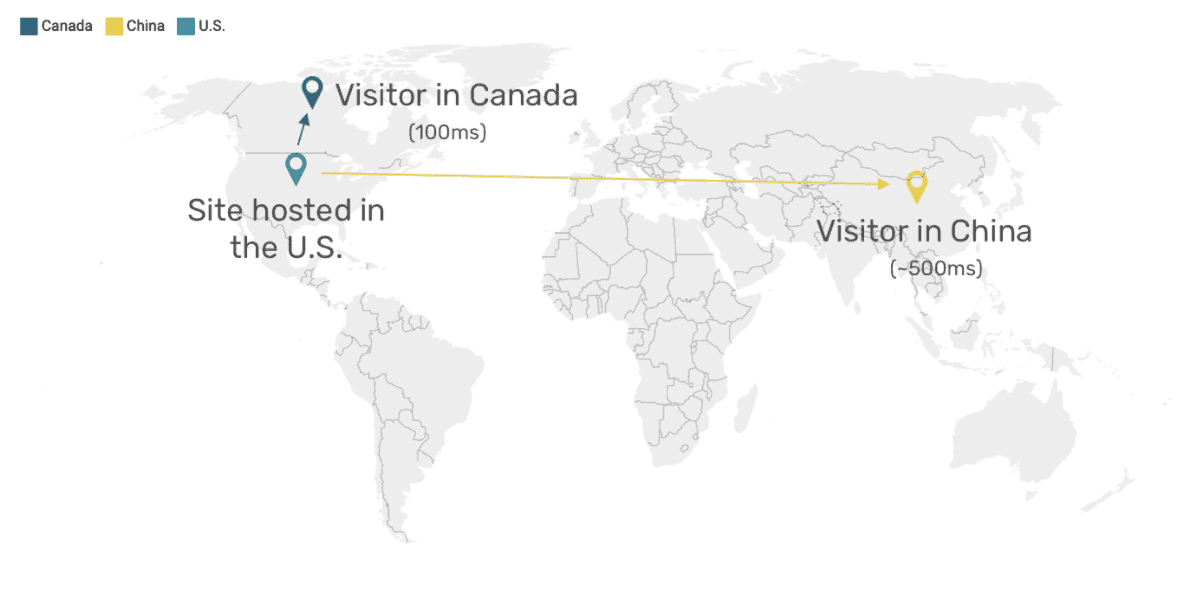
Why do most Drupal websites encounter functionality issues in China?
There are a number of technologies that are blocked or slow to load in China.
This includes essential libraries widely used by developers globally, popular plugins, and or default components that website building platforms inherently include out of the box.
Most modern websites are composed of hundreds of these resources.
When a browser attempts to load a blocked resource, the web browser will keep trying to retrieve the file for a period of time before it moves onto the next resource. As a result, the loading process get's 'stuck'. This blocked resource then interferes with both the total loading time of the site and also impacts the functionality of the site after parts don’t load at all.
We can use the example below. This waterfall shows when a China visitor attempted to load resources past Facebook trackers, a resource that is blocked in China.
Note that even after 35 seconds, only 30% of this website's resources have loaded properly.
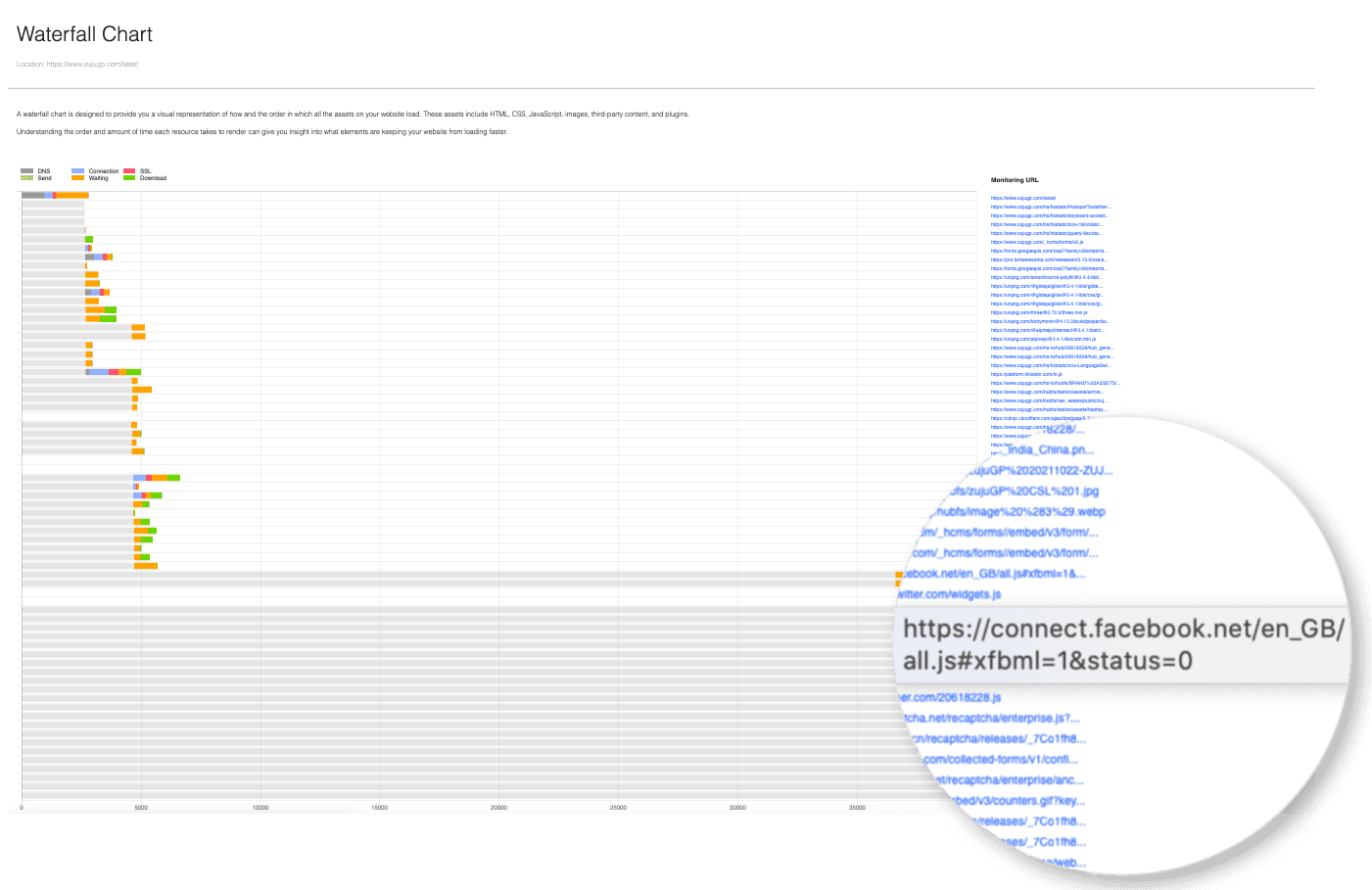
What happens when your site has blocked or slow-loading resources? You end up with a site that loads both partially and slowly, at times taking upwards of 30 seconds
Common mistakes when optimizing Drupal websites for China
Traditionally, when a website encounters performance issues - a developer might check whether their code can be streamlined, consider hosting it closer to the end user, or adding a content delivery network.
The solution is a little less straightforward when it comes to China.
i) Only working on Hosting
While hosting may speed up your website loading thanks to onshore performance gains, hosting a website near or in China still does not resolve any code-based incompatibilities or unoptimised third-party resources (i.e. third party hosted asset files, video embeds, analytics etc.) that your website might have.
Even if you decide to host a website in China (which Chinafy’s partners often help with), it’s important to note that there are a number of pre-requisites you must meet as set by the Ministry of Industry and Information Technology for China. Some of these requirements include but are not limited to -
ICP registration
China business entity: A requirement for the ICP licence
PSB Filing and more
What is an ICP licence?
The ICP permit allows you to host your website on a mainland Chinese server. All websites who wish to be hosted onshore are required to apply for and receive one before going live - a rule enforced by whoever hosts your domain name (e.g. your Service Provider or Content Delivery Network (CDN)).
This would also require you to evolve your site on an ongoing basis, managing a list of blocked or inaccessible resources to find China-friendly alternatives.
What is an ICP? Need an ICP? Contact Chinafy ICP Support to enquire further.
ii) Relying solely on CDNs
A Content Delivery Network (CDN) is a distributed network of servers that stores your web resources nearer your end-users, improving performance. CDNs targeted for China can be great for accelerating regional delivery. However, whether they are on-shore in China or near China, CDNs are at best, a partial fix as they still cannot accelerate third-party resources nor resolve any inaccessible resources in China.
Videos embedded on YouTube and Vimeo, Facebook trackers, and other third party resources will still be inaccessible, contributing to the issues of slow loading on the site level.
How to prepare your Drupal website for the China market?
1. Address technological incompatibilities
Tackling both code-based incompatibilities and infrastructure issues are crucial in addressing technological incompatibilities of your site as a whole. By addressing both these issues, Chinafy optimizes your site to improve:
i) Functionality: Chinafy bolts onto a website to optimize both primary and third party resources. This translates into an improvement in how the website is experienced by the user across images, videos, and interactive elements like forms. The broader impact on this is in most cases, a higher engagement rate and lower bounce rates.
ii) Faster loading speeds: Most websites experience an improvement of 6-8x acceleration across their resources. Besides a faster loading speed, other improved metrics include resource deliverability rate and consistency of that loading experience.
For example, the Banyan Tree Hotel Group used Chinafy to achieve a much more stable and consistent loading time in China.
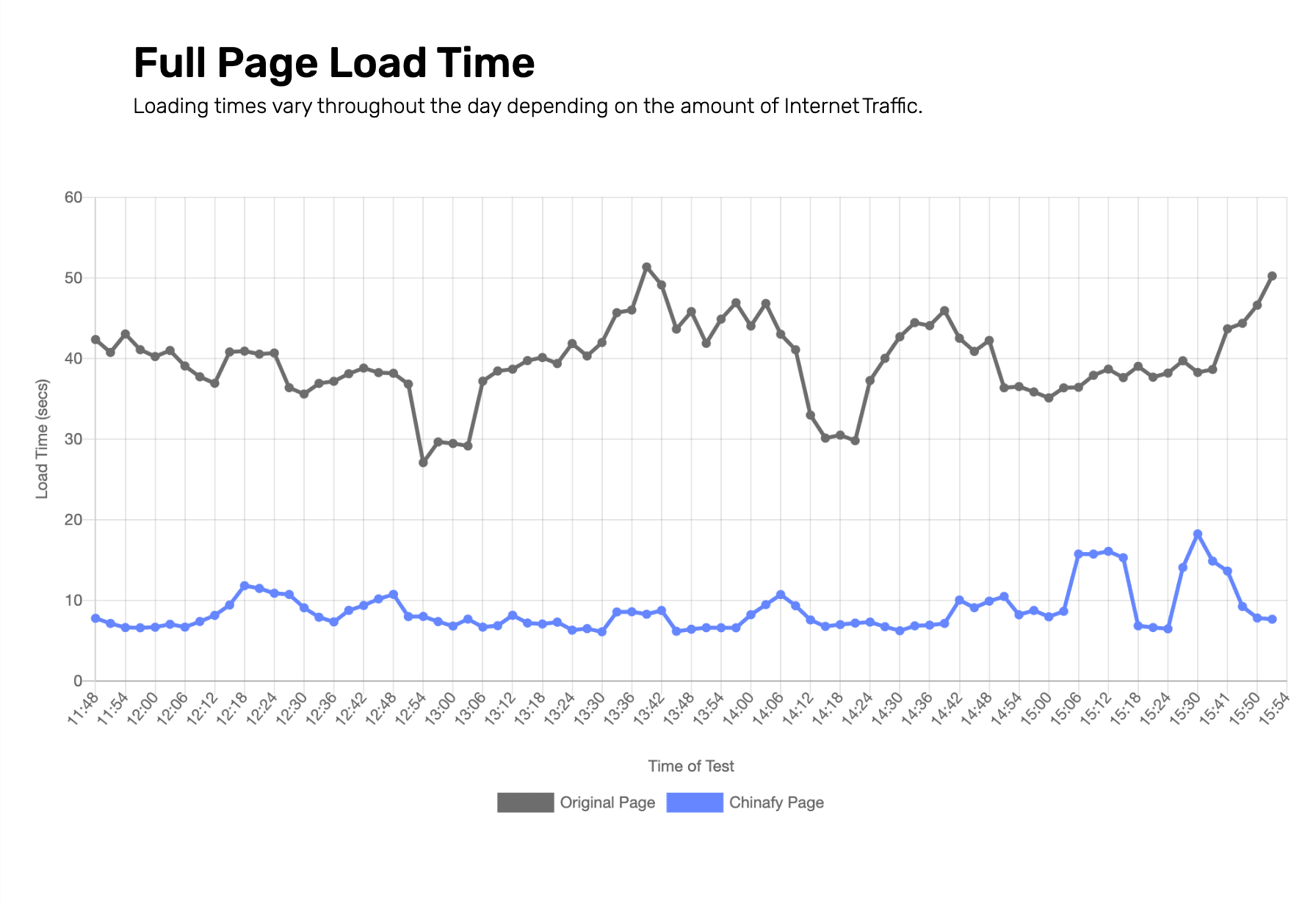
The above chart is a 4-hour time series analysis that compares the Banyan Tree Hotel website (in gray) alongside its Chinay version in Beijing (in blue). (Source: Chinafy)
iii) Improved reliability & deliverability: Inaccessible resources not only “break” the website but inhibit other resources from loading properly. By combining Chinafy’s web compatibility suite and a fully managed content delivery network (CDN), Chinafy can ensure that the website as a whole is delivered quickly and reliably to users in China. This can reduce the risk of website downtime and increase website reliability.
2. Localize your website content for China
Making sure to include Simplified Chinese content on your website to support the default local language of the China market brings multiple benefits.
According to research, Buyers in China are 92% more likely to buy a product with content in the local language and 52% will only purchase from websites in their own language. *1
Bear in mind that some of the most commonly used font files such as from Google Fonts and Adobe Typekit are either not optimized or are altogether inaccessible in China.
Knowledge of details and idiosyncrasies unique to China are also invaluable. One example for Baidu is to use pinyin in your website URLs
e.g. “www.website.com/zhong-wen” instead of “www.website.com/中文”
Other comprehensive options that can be optimized with Chinafy include:
Translation Proxies like WeGlot
Javascript Solution
Professional Translation Services
Works with multiple LSPs
3. Integrate local payment portals such as Alipay, WeChat Pay, and more
The ability to capture payment on your website from the China market is crucial, with Alipay and WeChat Pay alone estimated to account for over 90% of Chinese mobile payments with over a billion users between the two. *2
As China's go-to digital wallet, Alipay is often the first step merchants take to localizing a checkout experience for China visitors. Among offshore merchants, Alipay Global is a popular starting point. However, localization doesn't stop there.
Most global websites face compatibility issues that heavily impacts checkout journey from start, despite localized with Alipay and WeChat pay. For instance, most Shopify websites load in 36.8s in China vs. 3.8s in the U.S. (9.7x slower).

Chinafy works instantly with websites powered by Alipay by accelerating their loading speed and reducing friction points in the checkout experience in China.
4. Optimize and continue to improve content for improved SEO
The way your website is found by users in China is yet another crucial step in optimizing your Drupal site. As far as web search is concerned, Baidu is the dominant Chinese search engine with a 70% market share in the search engine ecosystem.
Is Baidu similar to Google?
Baidu is modelled similarly to Google with the exception of its unique SEO ecosystem entirely in Chinese. Powering search queries for map, image, video, and news and dominantly used by Chinese across all tiers of cities for everyday questions and products search, Baidu is the first touchpoint for any foreign business localizing for users in China.
Most commonly used by companies for two purposes, Search Engine Optimisation (SEO) and Search Engine Marketing (SEM)
SEO
To get started with Baidu SEO, sign up with a phone number registered in China.
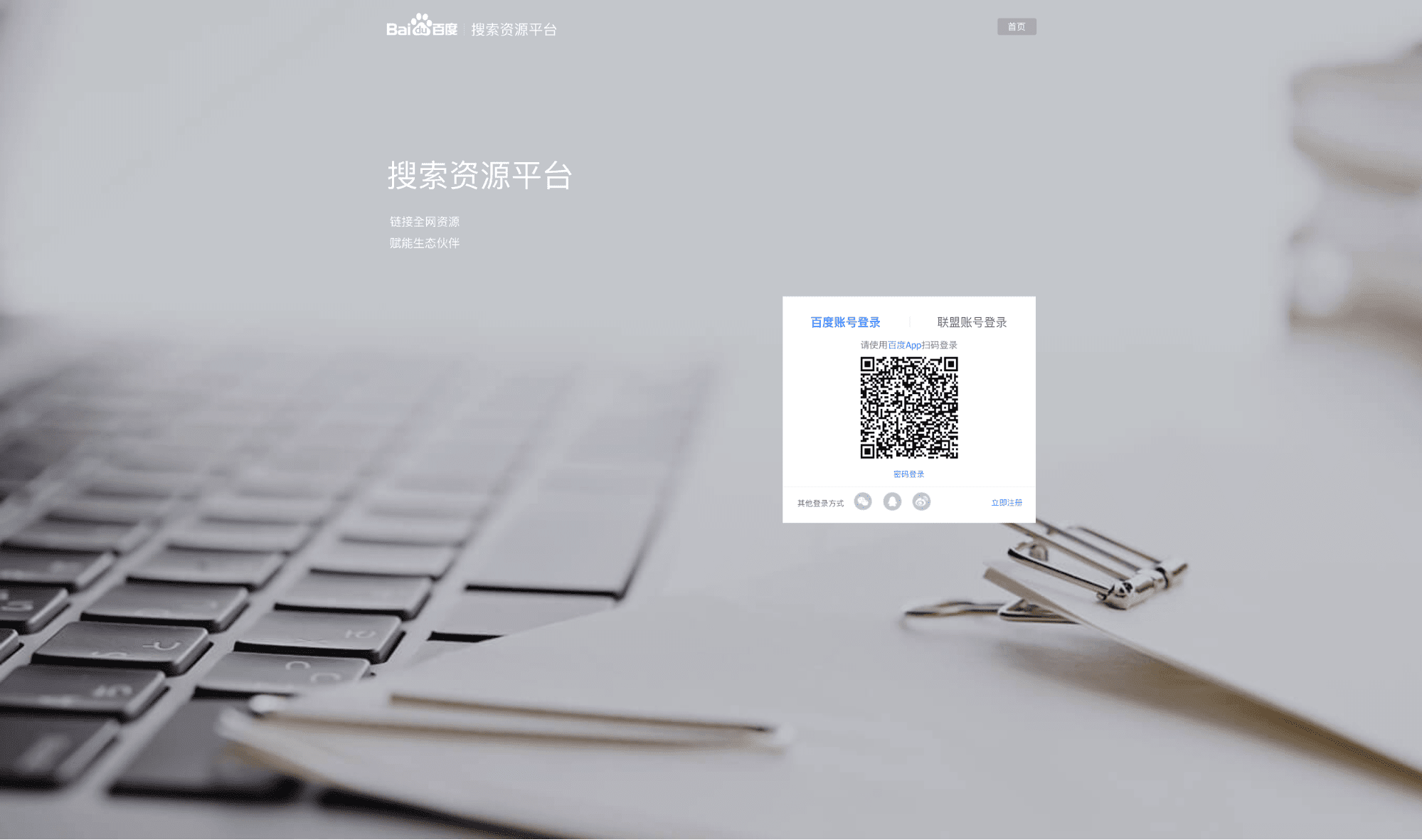
SEM
To get started with Baidu SEM, speak to a Baidu representative directly (Chinese only).
Alternatively, there are also other agencies offering Baidu advertising service.
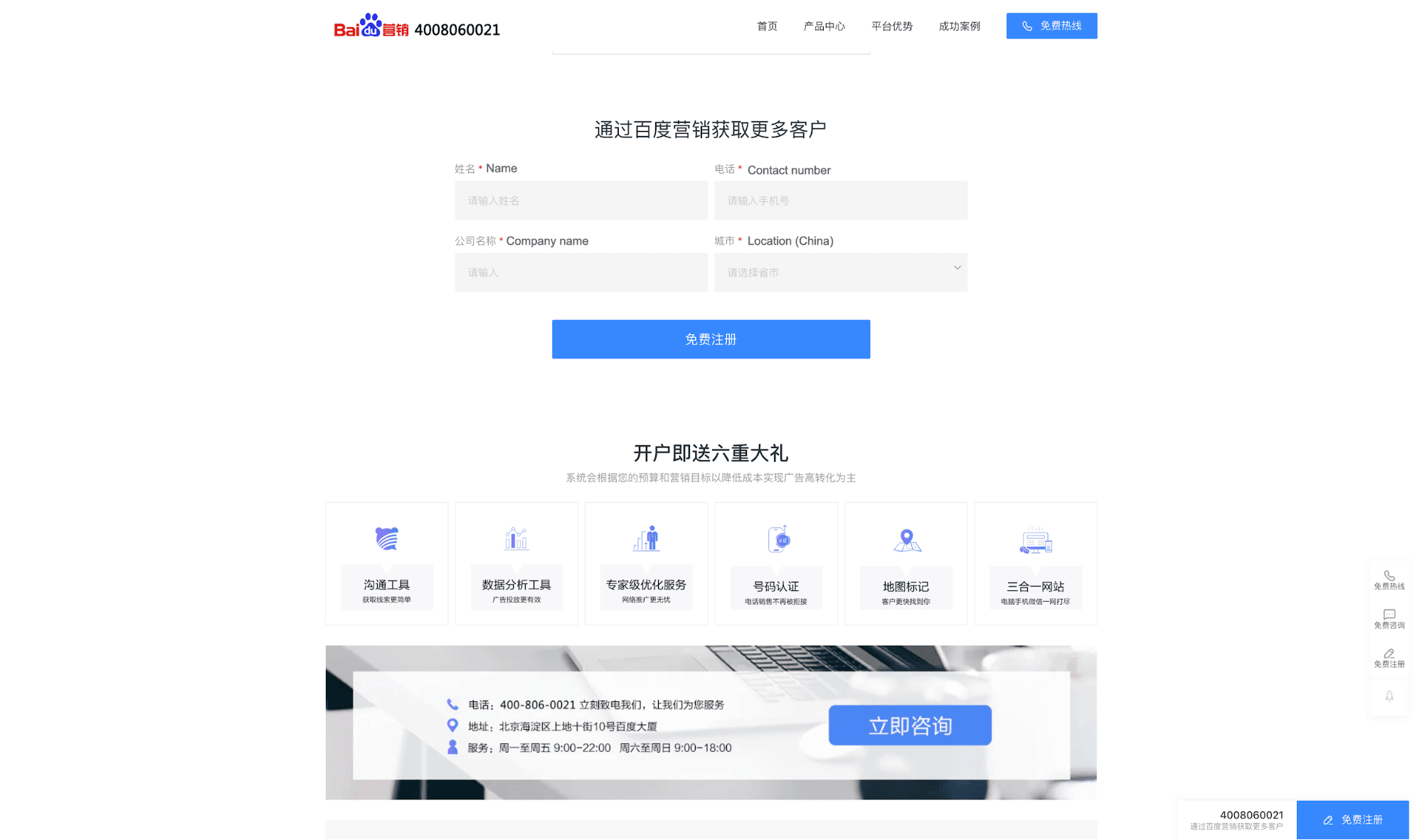
Further optimizing your content for Baidu is crucial in capturing China users, with some actionable tips including:
Making sure that your website loads fast and fully for China visitors. Most websites load slowly and or are broken when loading from China. Poorly performant websites are correlated with Baidu marking them as short or empty pages, which are automatically filtered out in search and is one of the areas Chinafy works on to improve in website performance.
Optimize for mobile, extra. Most Baidu users will be experiencing your content via mobile. Baidu also automatically transcodes your website content if it is not fast, performative or mobile-friendly. This transcoded version may affect your UX/UI. Prevent this by making sure that your website is i) optimised for a performance (see point #1) and ii) mobile-friendly in its design.
Ensure that your web content is unique. While duplicate content is both penalised across Google & Baidu, Baidu is designed to filter out duplicate content. This means, if you have content copied in more than one place, Baidu will not include it.
Indexing your URLs. You can auto-push your URLs to Baidu (which Chinafy does automatically for all users, more on this later!) or do so via Baidu Webmaster.
Generate long-form content. As hinted above, Baidu filters out pages that are slow, deemed empty, or short. Make sure your pages have searchable content.
Use more HTML, and less Javascript. Baidu’s search engine prefers crawling HTML. The engine encounters difficulty in processing Javascript or at least does not prioritise it the same way as Google. As a result, your JS content may not be processed correctly.
Avoid Pop-ups. Baidu’s search engine spider penalises websites that have low-quality pop up windows and malicious content.
Internal & external Links: You should be doing this for your Google search results already, but make sure you work on both internal and external for your Chinese pages as well.
Tip: Baidu indexes non-hyperlinked URLs as a positive variable, unlike a number of other search engines. This means you should include these within your text to improve your overall search rankings.
Keywords, keywords, keywords: It’s worthwhile knowing what your keywords are in simplified Chinese, as you would in your other website language and including them in your meta descriptions and title tags Baidu still includes these as ranking factors as of 2022, unlike Google.
Use pinyin in your website URLs…e.g. “www.website.com/zhong-wen” instead of “www.website.com/中文”
Marketing and Paid Advertising
Once you have optimised your site, gotten a good sense of your ‘base’ traffic/visitor engagement, and taken the steps to improve your odds of ranking well, you can consider paid traffic campaigns to your content or building out local Chinese social media channels to support your growth. Some of the most popular include:
WeChat is China's most downloaded messaging and social networking app. Locally known as Weixin, WeChat is now a daily necessity among family, friends, and businesses. WeChat is evolving into a Super App with its own robust ecosystem featuring tools such as WeChat Pay, WeChat Mini Program, and Moments.
Its simple user experience design has enabled deep market penetration across multiple age groups and cities of different tiers. With its diverse user demographics and cross-regional popularity, WeChat is often the first touchpoint for businesses - both local or global - for marketing outreach.
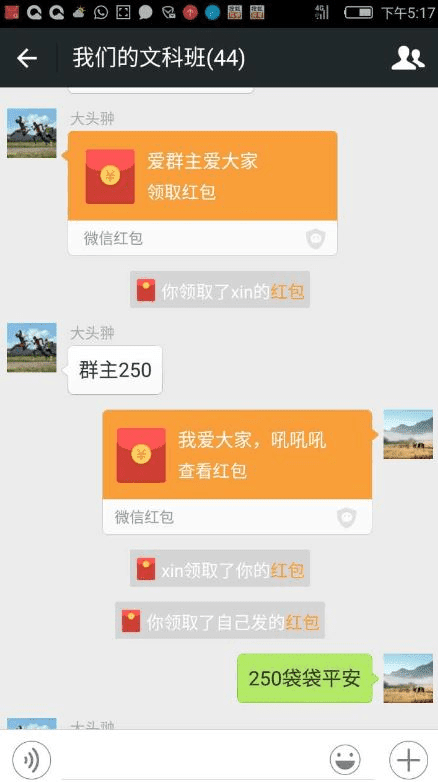
Weibo is a microblogging platform and one of the largest social media platforms in China.
As of 2020, Weibo has 550 million monthly active users browsing an array of topics ranging from news to light-hearted content like pets. Because of Weibo's massive user base, it is widely used by celebrities, media organisations, and even government officials for sharing news.
Weibo is often compared to China's Twitter – except it does not have a limited character count and provides e-commerce integration. Weibo's immense user base has made it a top choice for brand-building. International brands such as Apple are verified Official Weibo account users.
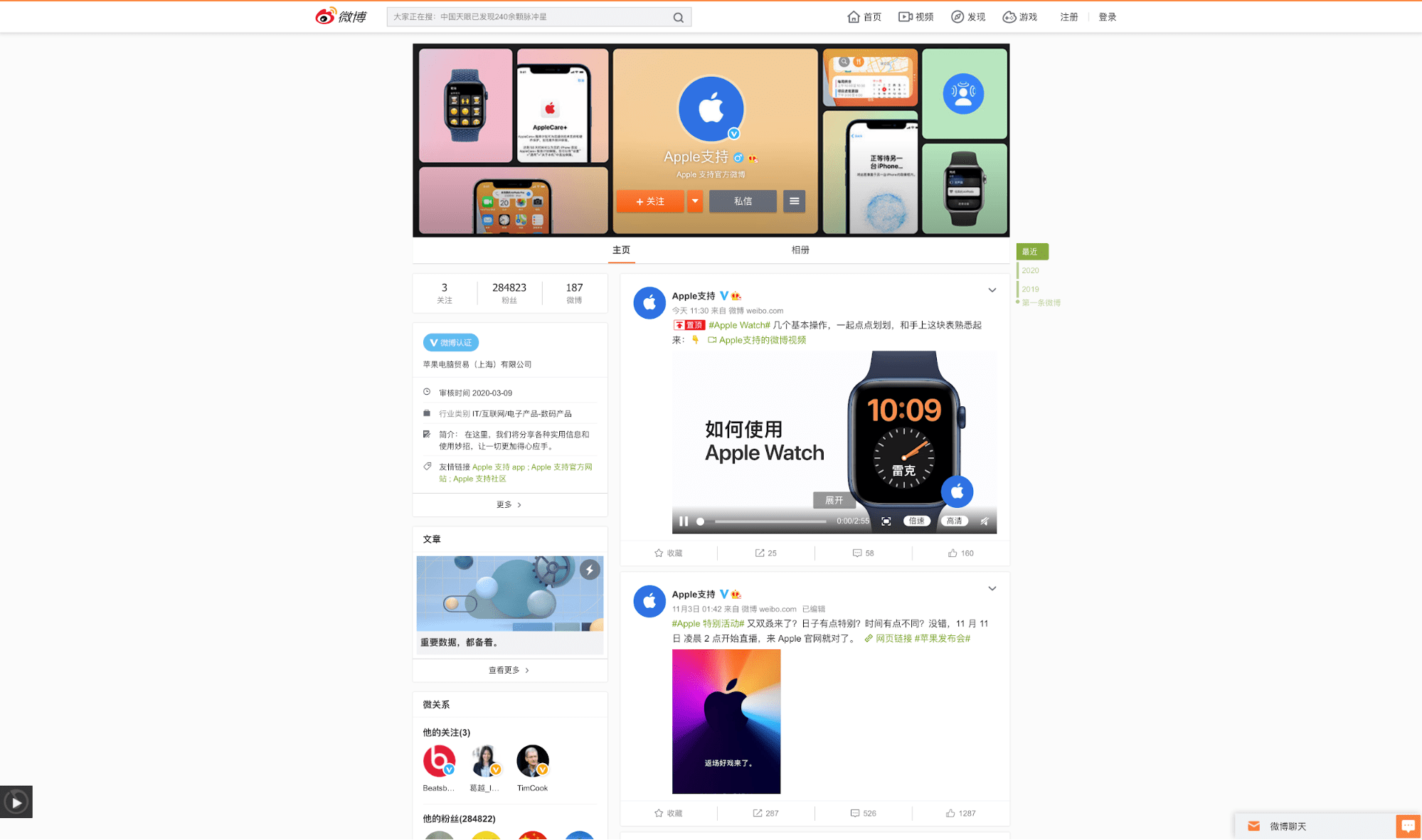
Drupal Case Study with Chinafy
One case study of a Chinafy client using Drupal is Novotech CRO.
The following is a snippet of the Novotech CRO case study. To read the full case study, click here.
Novotech CRO, a leading Asia-Pacific centred Biotech Contract Research Organization (CRO), manages labs, operates phase I facilities, and provides drug development consulting services and FDA regulatory expertise.
Novotech developed their website through their agency, Liquid Digital, to carry important information about their work. The website built on Pantheon and Drupal encountered an average of 24.5 seconds to load in China and came to Chinafy for a solution.
In less than two weeks to launch, the Novotech website saw an average improvement in speed by 3.82x, leading to an improvement in website engagement metrics such as reduced bounce rates.
Not to mention, it took less than two weeks to launch this website with Chinafy.
Comparing the original website against the Chinafy version in Beijing, the average Page Complete time is as follows:
Before Chinafy: 24.5 seconds
After Chinafy: 6.4 seconds
A visual representation of the visual loading of the page against a timeframe in seconds:

In addition to the website loading optimization after working with Chinafy, Novotech was also able to:
Enable China users access to its full website without a VPN
Improve the ability for the Novotech team to track and index its website on
search engines, including Baidu
Optimise its website for China without needing a separate local site
or a new domain.
Continue to manage, edit, and review their content on their CMS setup with Pantheon and Drupal
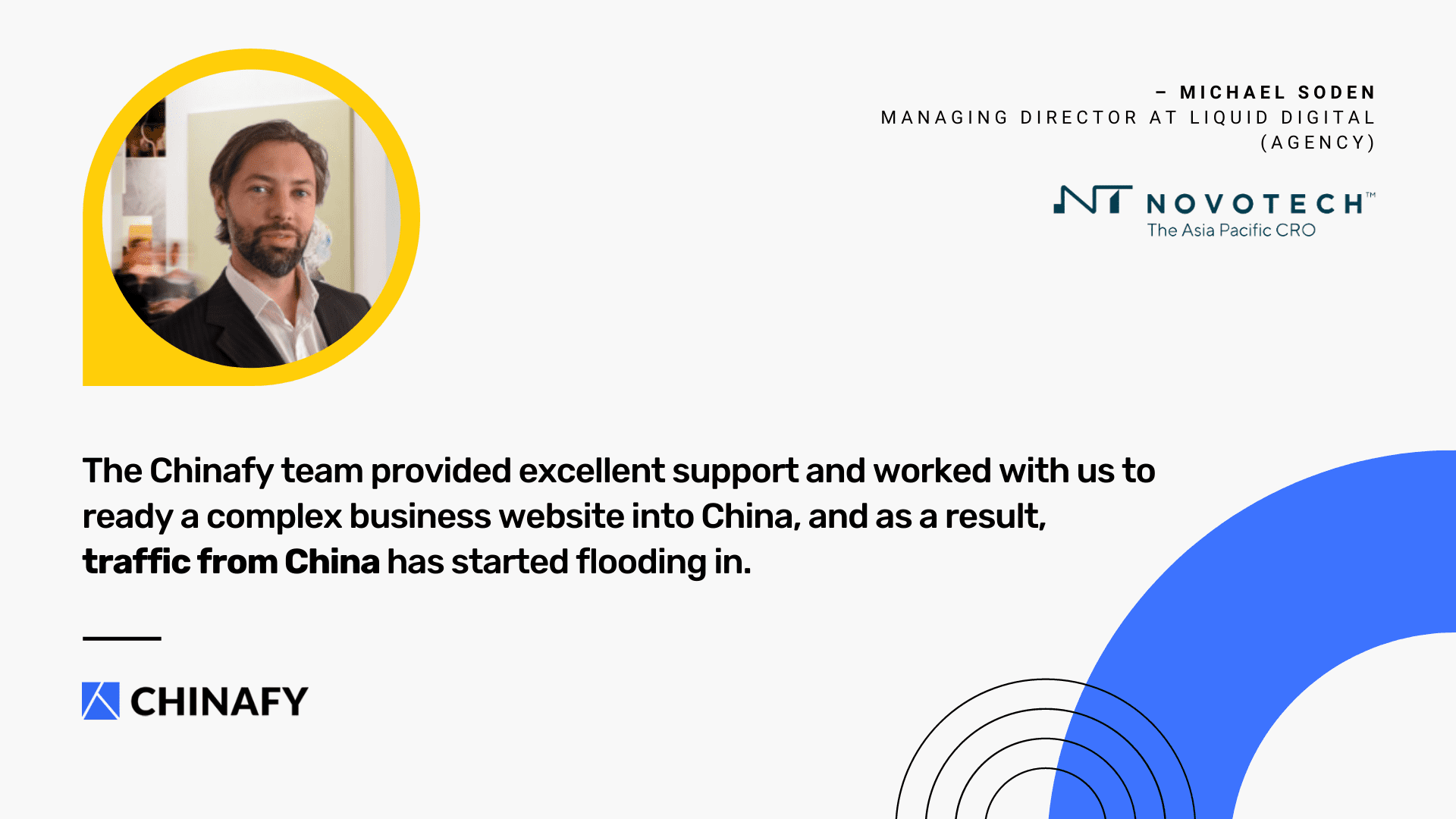
Drupal websites built in-house as well as with web development agencies like Specbee all stand to gain from the Chinafy service. Chinafy works with a whole host of external development firms, such as our client Novotech’s firm, Liquid Digital, to our partner agencies.
Want to test your Drupal Site’s load time in China?
Test your website across 5 servers in China (18 in total) which allow you to test the speed of your site(s) from around the world using various types of connections (i.e. 3G, LTE, Wifi).
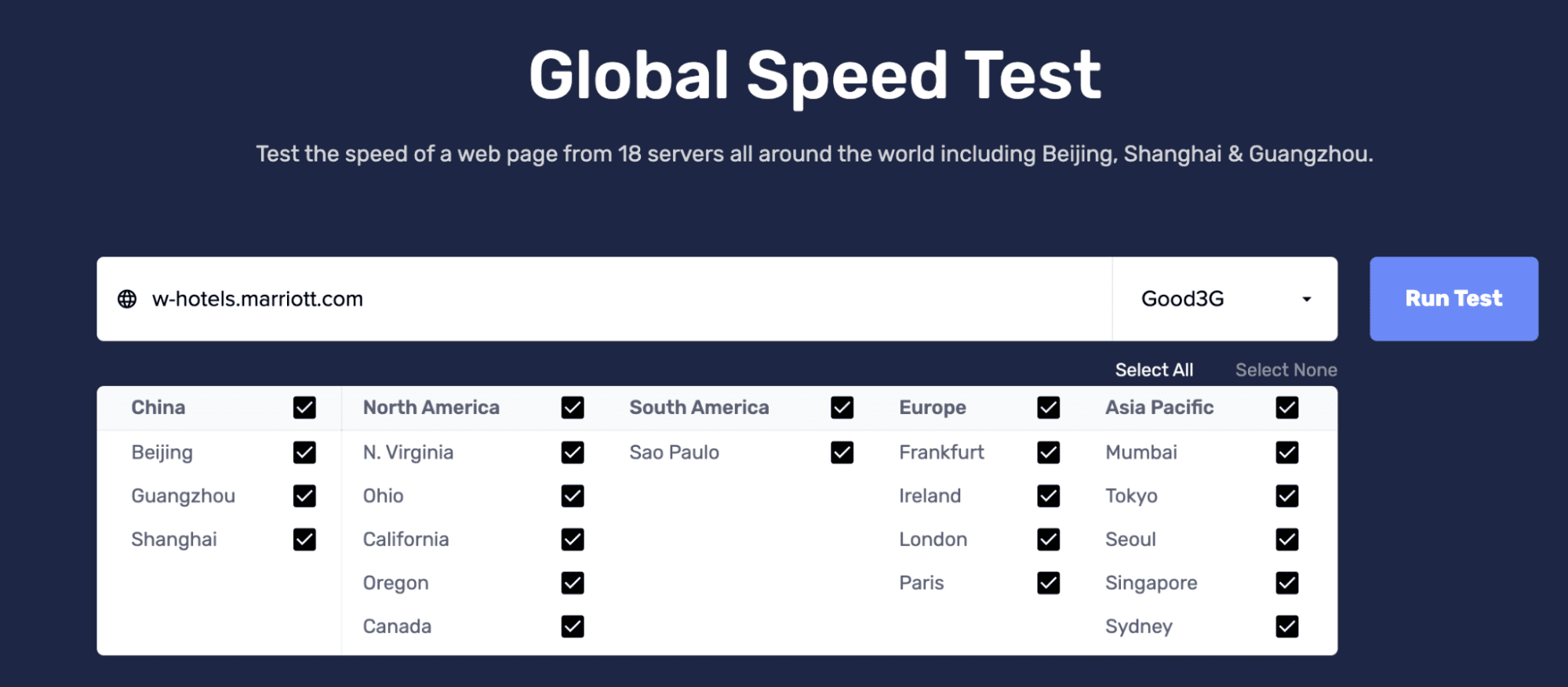
When the test is complete, hone into China n the results and you’ll see that while Loading Time is present, what’s potentially more important is the % Page size, or the # of Resources that successfully loaded (right side). It's normal to expect a variance between the # of resources from region to region. If China is > 5% then parts of the page (generally) are starting to not display properly.
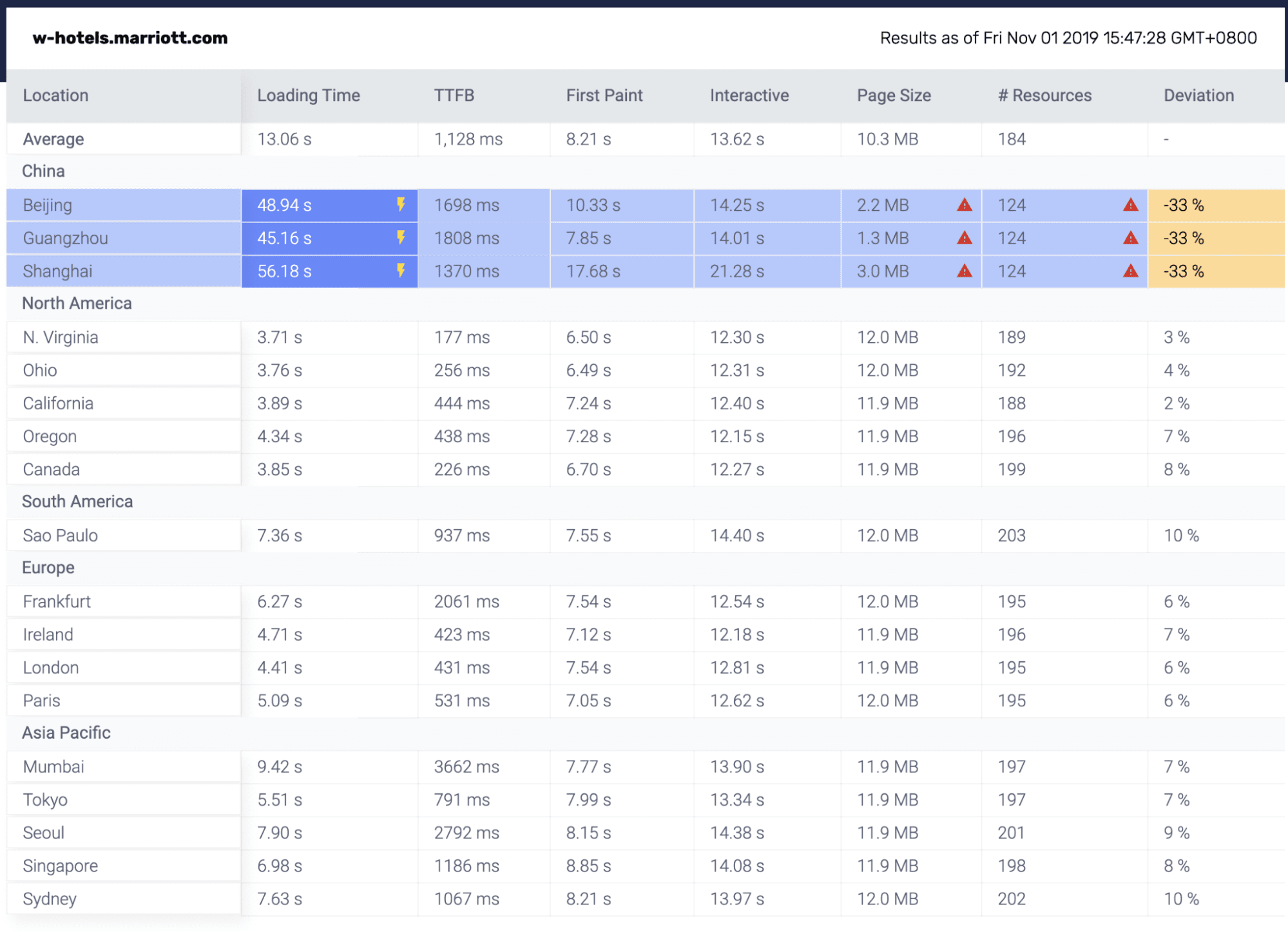
Test your website with a visual side by side comparison of accessing your site from China. With 18 global test locations and different network strengths and speeds available, this crucial test helps you recreate the user experience in China.
i) Enter your URL and select the connection type to run the test over.
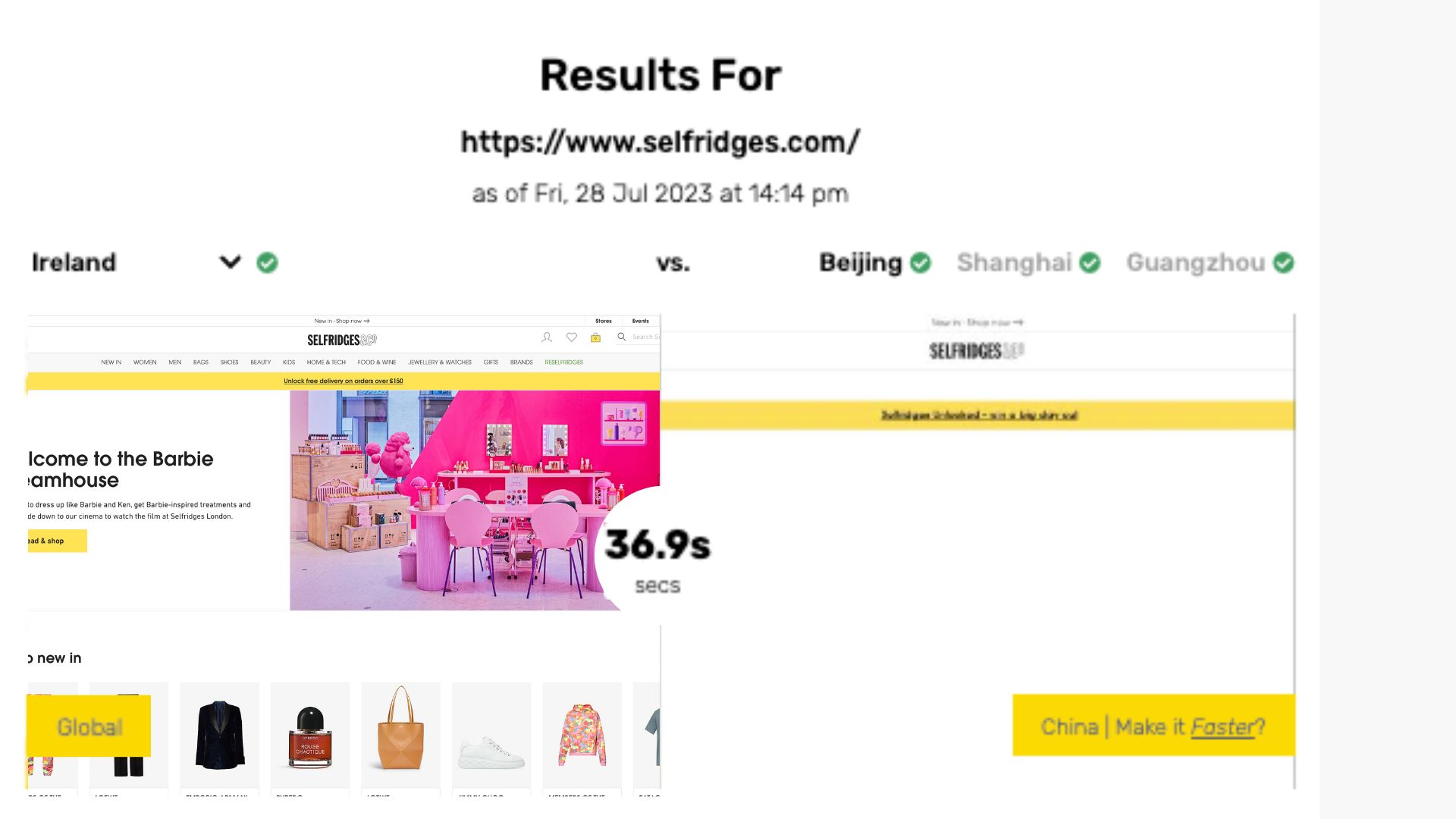
ii) Watch a live side by side comparison of your site loading.
Need more information? If you hover over a location, you can also hit the 'waterfall' icon to view the specific resource breakdown/waterfall. For more background on this test, read this article which goes into more detail.
Final takeaways
Drupal websites on their own do not necessarily work well in China, but can with Chinafy’s simple process. Chinafy can work in 2 weeks or less to achieve an optimized and fully-managed version of your website that’s 6-8x faster in China.
Click Get Started for Chinafy to review your site today

For more information on custom processes for Enterprise websites, please contact Enterprise Sales.



1 - Expected post-Chinafy results






























